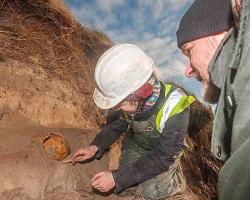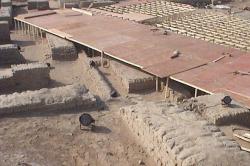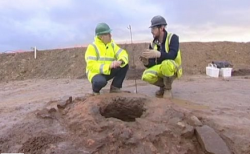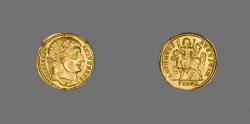INSTITUT SUPERIEUR D'ANTHROPOLOGIE
INSTITUTE OF ANTHROPOLOGY
ONLINE COURSES / COURS A DISTANCE
SPRING TERM : APRIL 2014
REGISTER NOW
ITALIE –  Milan - The remains of a pagan temple believed to have been devoted to the goddess Minerva have been found under the Milan Cathedral.The announcement was made Wednesday during the presentation of other archaeological finds, the remains of the ancient Mediolanum Forum discovered recently under the basement of the building housing the Pinacoteca Ambrosiana and the Biblioteca Ambrosiana.Archaeological excavations to unearth the remains of the large city that, beginning in 292 A.D., was the capital of the Western Roman Empire for over a century continue despite funding difficulties. So far, part of the floor made out of what is known as 'Verona stone' has been found. The base of a section of an arcade can also be seen. The entire forum occupied an estimated surface area of 166 by 55 square meters. While waiting to be able to extend the excavations, the zone has been fitted with a special entrance on the side of the building, walkways, and illustrative signs to make visits by the public possible. The works were conducted with funding from the Cariplo foundation and the Lombardy regional government and are part of the project for a 'Milan Archaeology' route being readied for the 2015 Milano Expo, said regional culture councillor Cristina Cappellini.
Milan - The remains of a pagan temple believed to have been devoted to the goddess Minerva have been found under the Milan Cathedral.The announcement was made Wednesday during the presentation of other archaeological finds, the remains of the ancient Mediolanum Forum discovered recently under the basement of the building housing the Pinacoteca Ambrosiana and the Biblioteca Ambrosiana.Archaeological excavations to unearth the remains of the large city that, beginning in 292 A.D., was the capital of the Western Roman Empire for over a century continue despite funding difficulties. So far, part of the floor made out of what is known as 'Verona stone' has been found. The base of a section of an arcade can also be seen. The entire forum occupied an estimated surface area of 166 by 55 square meters. While waiting to be able to extend the excavations, the zone has been fitted with a special entrance on the side of the building, walkways, and illustrative signs to make visits by the public possible. The works were conducted with funding from the Cariplo foundation and the Lombardy regional government and are part of the project for a 'Milan Archaeology' route being readied for the 2015 Milano Expo, said regional culture councillor Cristina Cappellini.
http://www.ansa.it/web/notizie/rubriche/english/2014/01/29/Pagan-temple-remains-unearthed-Milan-Cathedral_9982795.html
INDE - Chechar -State archaeology officials confirmed that ongoing excavations at Chechar village had unearthed the relics, apparently dating back to the 5th Century AD. The Gupta age lasted roughly from the 4th to the 6th Century AD. "At no other site have the remains of the Gupta age settlements been discovered hardly six feet below the ground," said archaeologist Arun Kumar. "A whole concrete floor has been discovered and there is evidence of piling below it. The wall over it must have been above the ground, which no longer exists. It must have been part of a huge temple." For the past few weeks, archaeologists have been digging two trenches at Chechar village – a well-known Neolithic site with evidence of unbroken historical and cultural sequences down to the present day. Situated nearly 50km from state capital Patna, the site has divulged red and black pottery phases, Mauryan artefacts and even evidence of the pre-Mughal period. The site has also yielded evidence of its connections with the Buddha. Though the Archaeological Survey of India (ASI) had conducted excavations here in 1977-78, not much progress was made later. Bihar chief minister Nitish Kumar, who visited the site a few months ago, had directed state archaeology officials to begin excavations all over again. Archaeologist Arun Kumar said that much before the formal excavations had begun, locals had discovered sculptures, coins, clay and metal pots, jewels and figurines of the ancient age in superficial diggings.
http://www.hindustantimes.com/india-news/relics-of-india-s-golden-age-discovered-in-bihar/article1-1178420.aspx
ROYAUME UNI –  Deerness - Archaeologists have carried out a rescue dig after shoreline storm damage in Deerness revealed human remains. Heavy seas took away the top layer of a grassy bank leaving the badly damaged remains – thought to be several hundreds of years old – exposed to the elements. With funding for a rapid response excavation from Historic Scotland, experts from the Orkney Research Centre for Archaeology (ORCA) carried out the task of uncovering and removing the skull and other bones from the site in Deerness. Orkney’s county archaeologist Julie Gibson said: “Urgent work was needed before further damage occurred – there was a strong possibility that this important find could have been swept away. “Because they were buried in sand, the bones are in good condition. They were treated with great respect as the painstaking task to remove them to safe keeping was carried out. “A partial skeleton emerged. An initial assessment would suggest that these are the remains of an elderly man. We’ll find out the age of the bones once radio carbon dating has taken place.”
Deerness - Archaeologists have carried out a rescue dig after shoreline storm damage in Deerness revealed human remains. Heavy seas took away the top layer of a grassy bank leaving the badly damaged remains – thought to be several hundreds of years old – exposed to the elements. With funding for a rapid response excavation from Historic Scotland, experts from the Orkney Research Centre for Archaeology (ORCA) carried out the task of uncovering and removing the skull and other bones from the site in Deerness. Orkney’s county archaeologist Julie Gibson said: “Urgent work was needed before further damage occurred – there was a strong possibility that this important find could have been swept away. “Because they were buried in sand, the bones are in good condition. They were treated with great respect as the painstaking task to remove them to safe keeping was carried out. “A partial skeleton emerged. An initial assessment would suggest that these are the remains of an elderly man. We’ll find out the age of the bones once radio carbon dating has taken place.”
http://www.orcadian.co.uk/2014/01/exposed-remains-recovered-after-seas-batter-coast/
PAKISTAN –  Moenjodaro - Bhutto Zardari, the heir to slain former prime minister Benazir Bhutto, has launched a campaign to conserve the heritage of his home province of Sindh with a two-week festival due to begin on Feb. 1.But experts claim that the festival’s inaugural ceremony, which is to be held on the ruins of the Moenjodaro settlement, could endanger the UNESCO World Heritage site built around 2600 BC. Large wooden and steel scaffolds are being erected over and around the ruins, while heavy spotlights and lasers have been installed for a light show.Taking notice of reports that an 80 feet wide and 60 feet long stage was being constructed at the historic site and could damage its archaeological integrity, the Sindh High Court on Thursday evening ordered any offending construction to be immediately halted unless “extreme care” is taken in making arrangements for the show to prevent a “great national tragedy.”
Moenjodaro - Bhutto Zardari, the heir to slain former prime minister Benazir Bhutto, has launched a campaign to conserve the heritage of his home province of Sindh with a two-week festival due to begin on Feb. 1.But experts claim that the festival’s inaugural ceremony, which is to be held on the ruins of the Moenjodaro settlement, could endanger the UNESCO World Heritage site built around 2600 BC. Large wooden and steel scaffolds are being erected over and around the ruins, while heavy spotlights and lasers have been installed for a light show.Taking notice of reports that an 80 feet wide and 60 feet long stage was being constructed at the historic site and could damage its archaeological integrity, the Sindh High Court on Thursday evening ordered any offending construction to be immediately halted unless “extreme care” is taken in making arrangements for the show to prevent a “great national tragedy.”
http://newsweekpakistan.com/sindh-festival-could-damage-moenjodaro-ruins-experts-claim/
ROYAUME UNI –  Bexhill - Archaeologists from Oxford surveying the site of a controversial road scheme have found flint tools dating back 12,000 years. The scientists have been carrying out excavations along the route of the Bexhill to Hastings link road in Sussex. Protesters say the road is unnecessary and a blight on the landscape. But its construction is giving archaeologists a unique opportunity to discover more about the way our ancient ancestors lived. Malcolm Shaw reports.
Bexhill - Archaeologists from Oxford surveying the site of a controversial road scheme have found flint tools dating back 12,000 years. The scientists have been carrying out excavations along the route of the Bexhill to Hastings link road in Sussex. Protesters say the road is unnecessary and a blight on the landscape. But its construction is giving archaeologists a unique opportunity to discover more about the way our ancient ancestors lived. Malcolm Shaw reports.
VIDEO = http://www.itv.com/news/meridian/update/2014-01-30/archaeologists-make-discovery-on-site-of-controversial-road-scheme/?
IRLANDE –  Dúnbeg- Serious damage has been done to an important Iron Age fort on the Dingle peninsula. Much of the western wall of the dramatically perched cliff stone structure at Dúnbeg fell into the sea in recent days and the site has been closed from the roadway at Slea Head. The Dúnbeg fort, precariously located on a sheer cliff jutting south into Dingle Bay, has long been identified as vulnerable and a full archaeological assessment was carried out in the late 1970s. Excavation results show its earliest phase may date to the Bronze Age, around 800 BC, but it was in use throughout the Celtic period.
Dúnbeg- Serious damage has been done to an important Iron Age fort on the Dingle peninsula. Much of the western wall of the dramatically perched cliff stone structure at Dúnbeg fell into the sea in recent days and the site has been closed from the roadway at Slea Head. The Dúnbeg fort, precariously located on a sheer cliff jutting south into Dingle Bay, has long been identified as vulnerable and a full archaeological assessment was carried out in the late 1970s. Excavation results show its earliest phase may date to the Bronze Age, around 800 BC, but it was in use throughout the Celtic period.
http://www.irishtimes.com/news/environment/part-of-iron-age-fort-at-d%C3%BAnbeg-in-dingle-falls-into-sea-1.1673526?
TURQUIE –  Antioche - A research team from the University of Cincinatti, US, managed to visualize the political borders of the ancient metropolis of Antioch using technological elements provided by Google Earth. The research team, an inspiration of Kristina Neumann, a doctoral candidate the University’s McMicken College of Arts & Sciences Department of Classics, based their research on the allocation, scarcity and density of Antiochian coins of different periods. Neumann explains that she and colleagues created a database using already published excavation reports and coin hoards, importing it to Google Earth as a second step. Such an action allowed the team to show visually the way Antioch’s political influence changed as the Roman Empire took over. As stated in New Orbit website, Neumann catalogued the coins using info such as the city they were minted and under whose authority. ”My criteria are so detailed that I can see all the coins for a particular emperor or of a particular material.” she explains. What Neumann and co. finally indicated is that Antioch’s civic coins spread farther out than previously thought, having been particularly abundant along a trade route. Coins provide important data about a city’s political relationship among cities. If Antiochene coins were found in a neighboring city, it meant that a political agreement had been etched between the two governments. Given the above, Neumann who is, as she states, interested in the idea of empire, both physical but also cultural and influential, aims through her research to define additional ways in which a multiethnic and multicultural empire could last so long as the Roman one did.
Antioche - A research team from the University of Cincinatti, US, managed to visualize the political borders of the ancient metropolis of Antioch using technological elements provided by Google Earth. The research team, an inspiration of Kristina Neumann, a doctoral candidate the University’s McMicken College of Arts & Sciences Department of Classics, based their research on the allocation, scarcity and density of Antiochian coins of different periods. Neumann explains that she and colleagues created a database using already published excavation reports and coin hoards, importing it to Google Earth as a second step. Such an action allowed the team to show visually the way Antioch’s political influence changed as the Roman Empire took over. As stated in New Orbit website, Neumann catalogued the coins using info such as the city they were minted and under whose authority. ”My criteria are so detailed that I can see all the coins for a particular emperor or of a particular material.” she explains. What Neumann and co. finally indicated is that Antioch’s civic coins spread farther out than previously thought, having been particularly abundant along a trade route. Coins provide important data about a city’s political relationship among cities. If Antiochene coins were found in a neighboring city, it meant that a political agreement had been etched between the two governments. Given the above, Neumann who is, as she states, interested in the idea of empire, both physical but also cultural and influential, aims through her research to define additional ways in which a multiethnic and multicultural empire could last so long as the Roman one did.
http://www.archaiologia.gr/en/blog/2014/01/30/mapping-antiochs-influence/